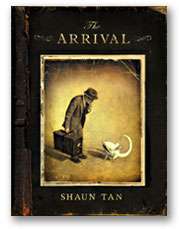The Arrival (graphic novel)
The Arrival by Shaun Tan is a wordless "graphic novel" published by Hodder Children's Books in 2006. The book is 128 pages long and divided into six chapters; it is composed of small, medium, and large panels, and often features pages of full artwork. It features an immigrant's life in an imaginary world that sometimes vaguely resembles our own. Without the use of dialogue or text, Shaun Tan portrays the experience of a father emigrating to a new land.[1] Tan differentiates The Arrival from children's picture books, explaining that there's more emphasis on continuity in texts with multiple frames and panels, and that a "graphic novel" text like his more closely resembles a film making process.[2] Shaun Tan has said he wanted his book to build a kind of empathy in readers: "In Australia, people don't stop to imagine what it's like for some of these refugees. They just see them as a problem once they're here, without thinking about the bigger picture. I don't expect the book to change anybody's opinion about things, but if it at least makes them pause to think, I'll feel as if I've succeeded in something."[3]
 First edition cover | |
| Author | Shaun Tan |
|---|---|
| Country | Australia |
| Language | English |
| Publisher | Hodder Children's Books |
Publication date | 2006 |
| Media type | Print (Hardback) |
| Pages | 128 |
| ISBN | 9780340969939 |
| OCLC | 768823420 |
| A823.3 | |
| Website | http://www.shauntan.net/books/the-arrival.html |
Synopsis
The Arrival tells a universal story of immigration. The story is about a man leaving his home to find work and support his family, whose home has apparently become unsafe. In the new land, the man goes through a lengthy administrative process and manages to find a small living space. Although he struggles to understand the different language, navigate the unknown city and to find a secure job, he makes new friends of the locals and learns of the struggles of other refugees that have fled their homes due to slavery and sought asylum from war, sharing his own experiences as well. Eventually, the man’s family joins him in the new land, and they settle into a new, happy life.
The "graphic novel" conveys messages of solitude, alienation, and hope in a foreign land.[4]
Style
Shaun Tan sets the mood of each scene with sepia-tone colour schemes, ranging from grayscale to bright gold. The illustrations are reminiscent of aged photos, and often feature realistic-looking humans in abstract and bizarre environments. The environments resemble a combination of futuristic and old-fashioned aesthetics.[4] Tan's process was one that used real-life models to create a storyboard. He also shot pictures in his garage, using a video camera and empty boxes to create lighting.[5] Shaun Tan has commented on the reason for this process: "I was very dependent on photography for a lot of the drawings, because they're photo-realistic. It's not my favorite style of working, and I didn't feel very confident. The other thing was continuity. When I started, I was drawing everything out of my head by hand, and I was finding that there were accumulating continuity problems—just little things that you notice subconsciously, like the length of a sleeve, how a lapel falls, where the rim of a hat is. The only way to register all of that properly was to photograph a lot of the stuff."[3] Shaun Tan has commented that he was influenced by The Snowman by Raymond Briggs.[6]
Reception
Awards
- Hugo Award Nominee for Best Related Book, 2008
- Angoulême International Comics Festival Prize for Best Comic Book (for French translation of The Arrival, "Là où Vont Nos Pères")
- Boston Globe-Horn Book Award, Special Citation, 2008
References
- The arrival.
- Tan, Shaun. "The Arrival". Retrieved 11 April 2013.
- "Stranger in a Strange Land: Interview with Shaun Tan".
- Yang, Gene. "Stranger in a Strange Land". New York Times. Retrieved 11 April 2013.
- Rotella, Carlo. "Shaun Tan's Wild Imagination". New York Times. Retrieved 11 April 2013.
- "The Arrival". Retrieved 11 April 2013.